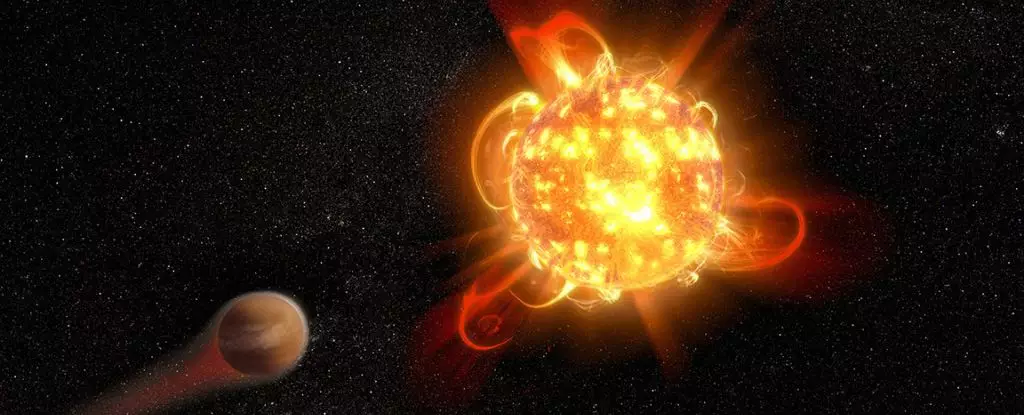M-class stars, commonly known as red dwarfs, have long captivated astrophysics enthusiasts due to their prevalence and unique characteristics. A staggering 70 percent of the stars in the Milky Way galaxy fall into this category, making these cooler, smaller celestial bodies some of the most abundant in the cosmos. Their lower temperatures enable them to burn their nuclear fuel exceptionally slowly, resulting in lifespans that can stretch into tens of billions of years. This longevity leads to the emerging idea that many red dwarfs might host planets that could potentially harbor life in their habitable zones, the region where conditions might be right for liquid water to exist.
The allure of red dwarfs intensifies when considering their stability and suitability for life. Scientists have posited that planets orbiting these stars might possess the necessary environments for complex life forms. However, this optimism might be overshadowed by a critical aspect of red dwarfs: their propensity to produce harmful stellar flares. New research is beginning to paint a concerning picture of the implications these flares have for any potential life forms residing in red dwarfs’ habitable zones.
Recent studies, particularly one focusing on a decade’s worth of data gathered from the now-retired GALEX space telescope, have ignited a serious reevaluation of the potential habitability of planets surrounding red dwarfs. Analyzing data from around 300,000 stars, this research dives deeper than past investigations, which primarily focused on optical wavelengths. It specifically centers on the ultraviolet (UV) radiation emitted during stellar flares, probing further into near UV (175–275 nm) and far UV (135–175 nm) emissions.
What’s alarming is the revelation that these UV emissions could endanger the atmosphere of planets orbiting red dwarfs. Historically, it’s been thought that moderate doses of high-energy photons from stellar flares could help catalyze the formation of complex organic molecules, essential for the emergence of life. However, excessive bursts of UV radiation can have devastating effects. They are capable of stripping atmospheres, undermining potential protective barriers like the ozone layer, which shields planets from harmful solar radiation.
The research also challenges previous assumptions about the nature of emissions from stellar flares. Traditionally, it has been common to model flare emissions based on a blackbody distribution, suggesting that these emissions adhere to a relatively predictable curve correlated with temperature. Such models estimated flare temperatures around 8,727 degrees Celsius (15,741 degrees Fahrenheit). Yet, recent findings indicate that this representation significantly underestimates the actual UV radiation emitted during these flares. In fact, approximately 98 percent of the flares examined exhibited UV outputs much higher than what these traditional models would predict.
This newfound understanding of flares implies that the electromagnetic radiation produced during such stellar events is more complex and varied than previously thought. The evidence suggests that relying on a singular model fails to encapsulate the true fury of flares emanating from red dwarfs. If stellar flares emit disproportionately high levels of UV radiation, the environments of orbiting planets might be crueler than scientists have anticipated. Habitability is not solely dictated by situational factors, such as temperature and the presence of water; rather, the intense radiation from nearby stars can alter those seemingly favorable conditions into hostile environments.
As astronomers push the boundaries of our knowledge regarding exoplanets, these findings urge us to reassess the criteria we employ in the search for extraterrestrial life. While notions of red dwarfs as promising candidates for hosting habitable planets may have fueled enthusiasm in astrobiology, the cold stark reality painted by recent studies draws a more complex narrative. It becomes imperative that scientists incorporate considerations of stellar emissions and their potential impacts on planetary atmospheres into their frameworks for evaluating potentially habitable worlds.
While M-class stars present unique opportunities in the cosmic landscape, the inherent dangers associated with their stellar flares cannot be ignored. These new insights underscore the necessity for a more meticulous examination of habitability surrounding red dwarfs. We stand at a pivotal moment in astrobiology where understanding the hidden threats of our universe may redefine our pursuit of alien life. The cosmos, as inviting as it may appear, can be a treacherous place filled with revelations that challenge our deepest assumptions.

Leave a Reply